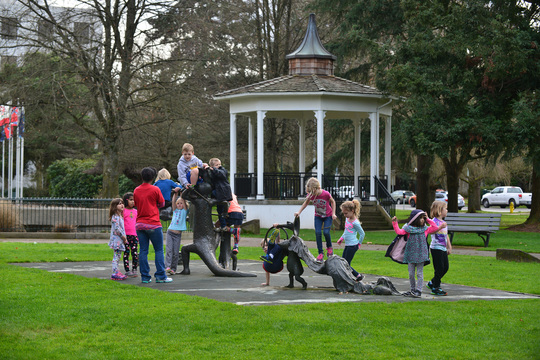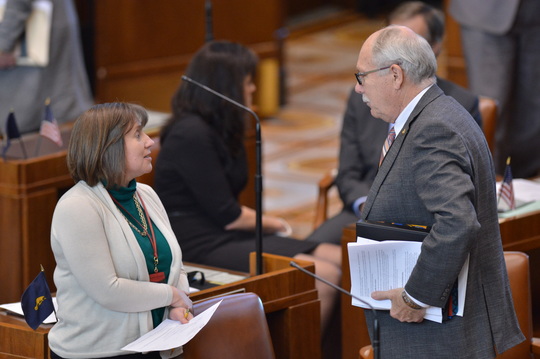To help students be successful, one size doesn’t fit all
By Senator Arnie Roblan and Representative Barbara Smith Warner
  Throughout our statewide tour of Oregon’s schools, members of the Legislature’s Joint Committee on Student Success have seen firsthand that one size does not fit all when it comes to helping Oregon’s students be successful. Never has that point been made clearer than on our tour last week of schools in Central Oregon.
On back to back days we toured a high school with one of the strictest regimes we’ve seen and another where students have almost unlimited freedom.
On Wednesday we visited an alternative high school where every minute of every student’s day is structured. From the instant they get out of bed at 6 a.m. cadets in the Oregon National Guard’s Oregon Youth Challenge Program outside of Bend are on the clock. They eat on schedule, attend class on schedule, exercise on schedule, study on schedule and go to bed on schedule.
It is the most successful program of its kind the country and succeeds for one segment of Oregon’s student population where everything else has failed. In most cases, the 22-week residential program is the last chance for students who have dropped out or are failing.
In stark contrast to OYCP, the high school students at the Redmond Proficiency Academy learn in a very unstructured environment. Students’ schedules more closely resemble those at the college level where seat time is reduced and completion of coursework outside of the classroom is maximized.
School leaders say that in a traditional high school time is the constant and learning the variable. At RPA they strive for learning to be the constant and time to be the variable. The downtown Redmond campus is open and students come and go on their own time table.
And both are successful. Each year a minimum of 250 OYCP students earn their high school diploma, a GED, or return to their high school ready to continue their academic careers. The graduation rate RPA exceeds the statewide rate by more than 6 percent and the list of awards won by the school and its students is exhaustive.
Different in approach. Similar in results.
 
One size does not fit all is also a good way to describe what committee members learned while touring the StepUp program at the Edwin Brown Education Center. StepUp encompasses the Redmond school district's transition program for 18- to 21-year-old students; a program for students who have been expelled; and the support program for students with behavioral, emotional and social needs. Program staff meet monthly with each school in the district to identify students with needs and seek, when possible, to meet those needs at the student’s existing school. Recent changes at the center include a team approach to determine the appropriate services for each student, tailoring a unique education experience to each individual’s needs.
While in Central Oregon, committee members also toured the International Baccalaureate programs at Bend High School and Pilot Butte Middle School, one of the few middle schools in Oregon to offer an IB option to students. We toured Mountain View High School and learned about its partnership with Central Oregon Community College which allows students to earn an Associates of Arts Oregon Transfer degree while in high school. At High Desert Middle School we saw one of the few dual language immersion programs offered at the middle school level.
Other site tours included learning about Elton Gregory Middle School’s use of the Advancement Via Individual Determination (AVID) curriculum; and a stop at Tumalo Community School.
Just like OYCP and RPA, each of these programs are meeting the needs of a particular segment of the student population in Oregon.
The committee also met face-to-face with students in both Bend and Redmond and held a series of roundtable discussions with area business people, educators and school safety officials. It’s inspiring to see firsthand that business owners, public safety officers, teachers, administrators, school board members and community leaders all want the same thing: success for Oregon’s students.
Senator Roblan and Representative Smith Warner are the co-chairs of the Legislature’s Joint Committee on Student Success. The committee was created to develop a plan to improve student success, including a budget proposal that ensures every student in Oregon, regardless of where they go to school, will have the opportunity to achieve success.

 Joint
Committee on Student Success Statewide Tour at a glance
Traveled 2,158 miles (from Salem) on trips to
Clackamas County, Marion County, Washington County, Lane County, Eastern
Oregon, Southern Oregon, Central Oregon and the Columbia River Gorge.
Held 8 public hearings
Conducted 10 student listening sessions involving 278
students from 42 schools (That includes meeting with the entire student body at
Arlington High School)
Held 8 roundtable discussions with area education and
community leaders.
Held 4 meetings with regional business leaders
Held additional round table meetings focused on school
safety; student health services and partnerships between high schools and
post-secondary institutions.
Toured 41 schools and programs in 25 cities, including:
- 12 high schools;
- 9 middle schools;
- 7 elementary schools;
- 4 charter schools;
- 4 alternative schools; and
- 1 tribal school
Today the committee has a full-day of meetings
and tours scheduled in Portland and East Multnomah County, including a public
hearing from 7 to 9 p.m. at Madison High School.
In October the committee will travel to the South
Coast for meetings and tours in Coquille and Coos Bay, including a public
hearing at Marshfield High School.
|
|